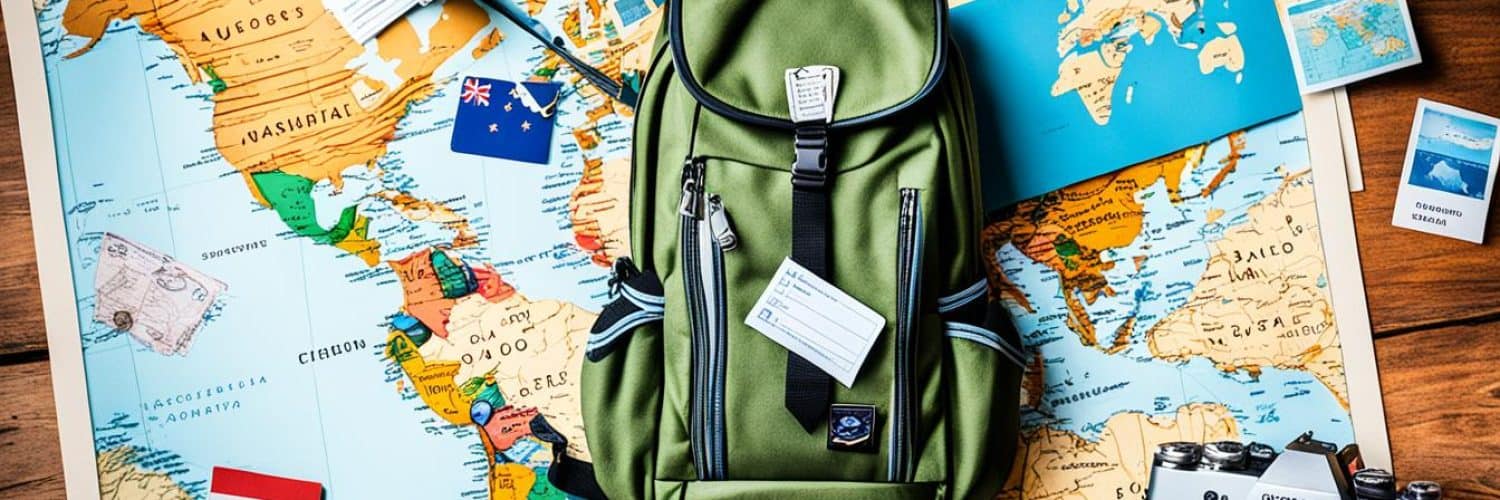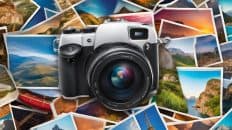Starting a travel blog can be an exciting and rewarding venture for those who love to travel and want to share their experiences with the world. Whether you’re a beginner or have some experience blogging, this step-by-step guide will provide you with all the information you need to start a successful travel blog. From choosing a niche and domain name to setting up your blog, creating content, and monetizing your blog, we’ve got you covered on your travel blogging journey.
Key Takeaways:
- Choose a niche that reflects your interests and target audience.
- Create a memorable blog name that reflects your brand and niche.
- Select the right blogging platform based on your technical skills and customization needs.
- Set up your travel blog by choosing a reliable hosting provider and registering a domain name.
- Create high-quality content that resonates with your target audience.
Choosing Your Travel Blog Niche and Domain Name
The first step in starting a travel blog is to choose a niche that reflects your interests and target audience. Consider what topics you are passionate about and what type of content you want to create. Some popular travel blog niches include budget traveling, luxury traveling, family-friendly traveling, and solo traveling.
Once you have chosen a niche, it’s time to brainstorm ideas for your blog name. Your blog name should be memorable and reflect your brand and niche. Keep it short, easy to spell, and most importantly, easy to remember. Think about names that capture the essence of your travel niche and resonate with your target audience.
After coming up with potential blog names, conduct a domain name search to ensure that your chosen blog name is available as a domain. Having a matching domain name is important for branding and establishing a professional online presence.
Need some inspiration for your travel blog niche and blog name? Here are a few ideas:
- Adventure Travel: Explore adrenaline-pumping activities and thrilling destinations.
- Food and Travel: Combine the love for food and travel by featuring culinary adventures around the world.
- Slow Travel: Embrace a slower pace of travel and focus on immersing in local cultures.
- Volunteer Travel: Share experiences and tips on volunteering while traveling, making a positive impact.
| Travel Blog Niche | Blog Name Ideas |
|---|---|
| Budget Traveling | PennyWiseWanderer |
| Fashion and Travel | StyleVentures |
| Wellness Travel | BlissfulJourneys |
| Adventure Travel | RoamingThrills |
Inspiration Quote: “The world is a book and those who do not travel read only one page.” – Saint Augustine
Remember, choosing the right travel blog niche and a catchy domain name are the first steps to creating a successful travel blog that resonates with your target audience. Take your time, brainstorm ideas, and let your passion for travel guide your decision-making process.
Now that you have chosen your travel blog niche and a memorable domain name, it’s time to select the right blogging platform to bring your vision to life. In the next section, we will explore the best platforms for travel blogging and help you make an informed decision.
Selecting the Right Blogging Platform
After choosing your travel blog niche and domain name, the next crucial step is selecting the right blogging platform to power your travel blog. Two popular options to consider are WordPress and website builders like Hostinger Website Builder. Each platform offers unique features and benefits tailored to different needs.
WordPress: The Best Blogging Platform for Customization
WordPress is a powerful content management system (CMS) that has emerged as the industry standard for bloggers. It boasts extensive customization options and a vast library of plugins and themes, allowing you to create a highly personalized and visually stunning travel blog.
With WordPress, you have complete control over your site’s backend, making it ideal for advanced users and those who want to explore more technical functionalities. From customizing your blog’s appearance to optimizing its performance, WordPress offers endless possibilities to bring your travel blog vision to life.
“WordPress is like a blank canvas that lets you create a unique masterpiece.”
Hostinger Website Builder: The Easiest Way to Build a Travel Blog
If you’re new to blogging or prefer a more user-friendly interface, Hostinger Website Builder is an excellent choice. It provides a simple and intuitive drag-and-drop editor, allowing beginners to create a professional-looking travel blog without any coding knowledge or technical skills.
With Hostinger Website Builder, you can easily customize your travel blog using pre-designed templates that are optimized for both desktop and mobile devices. The intuitive interface and seamless editing features make the website building process a breeze, enabling you to focus on creating compelling content for your travel audience.
“Hostinger Website Builder makes website creation as easy as building blocks.”
Choosing the Right Blogging Platform: Key Factors to Consider
When deciding between WordPress and Hostinger Website Builder for your travel blog, consider the following factors:
- Technical Skills: If you have advanced technical skills and prefer more control over your blog’s backend, WordPress is the ideal choice.
- User-Friendliness: If you’re a beginner or prefer an intuitive interface, Hostinger Website Builder is a great option.
- Customization: If you prioritize customization options, WordPress offers extensive flexibility to create a unique travel blog.
- Template Designs: If you want ready-to-use templates that are optimized for desktop and mobile, Hostinger Website Builder has a range of professional designs.
Ultimately, the best blogging platform for your travel blog depends on your specific needs and preferences. Consider your technical skills, customization requirements, and desired level of control when making your decision.
| WordPress | Hostinger Website Builder |
|---|---|
| Extensive customization options | Simple and intuitive drag-and-drop editor |
| Large library of plugins and themes | Ready-to-use templates optimized for desktop and mobile |
| More control over site’s backend | No coding knowledge or technical skills required |
| Steep learning curve | Beginner-friendly interface |
Setting Up Your Travel Blog
Now that you have chosen your niche and blogging platform, it’s time to bring your travel blog to life. Setting up your travel blog involves a few important steps to ensure a smooth and successful launch.
Choosing a Hosting Provider
First and foremost, you need to select a reliable hosting provider for your travel blog. A hosting provider is like the foundation of your blog, providing the necessary server space and resources for it to be accessible on the internet. Look for hosting providers that offer excellent performance, reliable security features, and good customer support. Popular hosting providers include Bluehost, DreamHost, and SiteGround.
Registering a Domain Name
To make your blog easily identifiable, you’ll need to register a domain name. A domain name is the web address that people will type in their browsers to reach your blog. Choose a domain name that reflects your blog’s name and niche, making it memorable and easy to spell. GoDaddy, Namecheap, and Google Domains are trusted platforms where you can register your domain.
Installing WordPress
WordPress is a widely-used and user-friendly content management system (CMS) that powers millions of websites and blogs. It offers a host of features and customization options to make your travel blog unique and visually appealing. Most hosting providers offer a one-click WordPress installation option, making it easy for you to set up WordPress and get started with your blog.
Customizing Your Blog
Once you have installed WordPress, it’s time to customize your travel blog to make it visually appealing and reflect your unique brand. Start by selecting a theme that matches your blog’s style and niche. You can find thousands of free and premium WordPress themes to choose from. Install essential plugins to enhance your blog’s functionality, such as plugins for SEO optimization, social media sharing, and contact forms. Take the time to explore the WordPress dashboard and familiarize yourself with its features, as it will be the control center of your travel blog.
As you customize your blog, consider your target audience and their preferences. A visually appealing and easy-to-navigate blog will attract and retain readers, encouraging them to explore more of your content.
In the next section, we will discuss how to create high-quality content for your travel blog, capturing the attention of your readers and establishing your authority in the travel blogging sphere.
Creating High-Quality Content for Your Travel Blog
Content is the heart of any travel blog. To create a successful travel blog, it’s essential to focus on creating high-quality, engaging, and informative content that resonates with your target audience. Here are some key tips for creating compelling travel blog content:
1. Blog Posts
Write well-researched and informative blog posts about your travel experiences. Share personal stories, tips, and recommendations to inspire and guide your readers. Use descriptive language to paint a vivid picture of the destinations you visit and include practical information like itineraries, budgets, and local insights.
2. Travel Guides
Create detailed travel guides that provide comprehensive information about specific destinations, including attractions, accommodations, transportation options, local customs, and safety tips. Use headings, subheadings, and bullet points to make your guides easy to read and navigate.
3. Travel Photography
Include stunning travel photographs in your blog posts to captivate your audience. Use high-resolution images that showcase the beauty of the places you’ve visited. Consider investing in a good camera and learning basic photography techniques to improve the quality of your photos.
4. Video Content
Enhance your travel blog with engaging videos. Record and edit travel vlogs, destination guides, or travel tips videos to provide a more immersive experience for your audience. YouTube and social media platforms like Instagram and TikTok are great platforms to share your travel videos.
5. Content Planning
Plan your content in advance to ensure a consistent posting schedule. Create an editorial calendar and brainstorm ideas for future blog posts. Consider seasonal trends, upcoming events, and popular travel topics. This will help you stay organized and maintain a steady flow of content on your blog.
Remember, the key to creating high-quality content is to provide value and engage your audience. Share your unique perspective, be informative, and always strive to inspire your readers to travel and explore the world.
By focusing on creating high-quality content across different formats like blog posts, travel guides, photography, and videos, you can build a successful travel blog that stands out from the competition. Don’t forget to incorporate search engine optimization (SEO) techniques in your content to attract organic traffic to your blog.
Monetizing Your Travel Blog
While the love of travel may be your primary motivation for starting a travel blog, there are also opportunities to monetize your passion. By implementing effective monetization strategies, you can turn your travel blog into a source of income. Let’s explore some popular monetization methods:
Affiliate Marketing for Travel Blogs
One popular way to monetize your travel blog is through affiliate marketing. By partnering with travel companies, hotels, and online booking platforms, you can earn a commission for every successful referral you generate. Recommend products, services, or destinations to your readers and provide them with affiliate links that track their purchases. When they make a booking or purchase through your links, you earn a commission.
Sponsored Content
Another monetization strategy is sponsored content. Travel brands may approach you to write posts featuring their products or services in exchange for compensation. When creating sponsored content, it’s important to maintain transparency and only work with brands that align with your blog’s niche and values. Be sure to disclose any sponsored partnerships to maintain trust and authenticity with your readers.
Display Advertising
Display advertising involves placing ads on your travel blog to generate income. You can join advertising networks, such as Google AdSense, and display relevant ads on your blog. When visitors click on these ads, you earn a portion of the advertising revenue. Ensure that the ads are relevant to your audience and placed strategically within your blog to optimize engagement.
Creating Products and Services
Adding your own products and services to your travel blog can be a lucrative monetization strategy. Consider creating travel guides, e-books, photography prints, or online courses that align with your blog’s niche. Your expertise and unique perspective can make these products valuable to your readers. Additionally, you can offer personalized travel consulting services or organize group tours to further monetize your blog.
Quote
“Monetizing your travel blog gives you the opportunity to turn your passion into a sustainable source of income. By exploring various monetization strategies, you can generate revenue while sharing your travel experiences with the world.” – [Author]
Remember, the key to successful monetization is to maintain the integrity and authenticity of your blog. Prioritize your readers’ trust and deliver valuable content alongside your monetization efforts.
Monetization Strategies Overview
| Monetization Strategy | Description |
|---|---|
| Affiliate Marketing | Earn commissions by promoting travel-related products and services through affiliate links. |
| Sponsored Content | Collaborate with travel brands to feature their products or services in exchange for compensation. |
| Display Advertising | Place relevant ads on your blog and earn income based on clicks or impressions. |
| Creating Products and Services | Develop and sell your own travel guides, e-books, photography prints, or offer personalized services. |
Promoting Your Travel Blog
To gain visibility and attract readers to your travel blog, it’s crucial to implement effective promotion strategies. By utilizing various channels and collaborating with industry influencers, you can expand your reach and engage with a wider audience. Here are some travel blog promotion strategies to help you get started:
1. Harness the Power of Social Media
Social media platforms are an excellent way to promote your travel blog and connect with your audience. Create engaging and shareable content that showcases your travel experiences. Be consistent in posting and interact with your followers by responding to comments and messages. Leverage popular platforms like Instagram, Facebook, and Twitter to share your blog posts, photos, and videos, and don’t forget to use relevant hashtags.
2. Guest Blogging for Expanded Reach
Consider collaborating with other travel bloggers by guest blogging on their platforms. This allows you to tap into their existing audience and build backlinks to your blog, which can improve your search engine rankings. Look for blogs that align with your niche and reach out to the owners with a well-crafted pitch. Guest blogging not only helps you expand your reach but also positions you as an authority in the travel blogging community.
3. Harness the Power of SEO
Implementing search engine optimization (SEO) strategies is essential for improving your blog’s visibility in search engine results. Research and target relevant keywords that are frequently searched by travelers. Optimize your blog posts by incorporating these keywords naturally into your content, titles, and meta descriptions. Pay attention to on-page SEO elements such as proper header tags, image alt tags, and internal linking. This will increase your blog’s chances of ranking higher in search engine results, driving organic traffic to your blog.
4. Collaborate with Bloggers and Influencers
Collaborating with other travel bloggers and influencers in the industry can have a significant impact on your blog’s promotion. Reach out to fellow bloggers and propose collaborative projects, such as joint blog posts, social media takeovers, or sharing each other’s content. By cross-promoting each other’s work, you can gain exposure to new audiences and tap into their loyal followers.
5. Engage in Community Forums and Groups
Active participation in travel-related forums and online communities is an effective way to promote your blog and interact with fellow travel enthusiasts. Join relevant travel groups on platforms like Facebook and LinkedIn and share your blog posts, tips, and advice. Engage in discussions, answer questions, and establish yourself as a helpful and knowledgeable member of the community. This can lead to increased visibility and potential readership for your blog.
6. Create Compelling Visual Content
Given the visual nature of travel, creating high-quality visual content is crucial. Invest in photography and videography equipment to capture stunning images and videos of your travel experiences. Share these visuals on your blog and social media platforms to spark the interest of your audience. Don’t forget to optimize your visual content by adding descriptive alt tags and appropriate metadata.
7. Offer Value through Freebies and Contests
Everyone loves freebies! Offer valuable resources, such as travel guides, checklists, or e-books, as freebies on your blog. Visitors will be more inclined to share their email addresses with you in exchange for these resources. This allows you to build an email list, which you can use to nurture relationships and promote your latest blog posts or products. Additionally, hosting giveaways and contests can generate buzz around your blog and increase engagement with your audience.
By implementing these travel blog promotion strategies, you can gain visibility, attract readers, and establish your presence in the travel blogging community. It’s essential to consistently evaluate and adjust your promotion efforts based on analytics and feedback to ensure the growth and success of your travel blog.
Building and Engaging Your Travel Blog Community
Building a strong and engaged community around your travel blog is crucial for long-term success. By fostering connections with your readers, you can create a loyal following and establish meaningful relationships. Here are some strategies to help you build and engage your travel blog community:
1. Responding to Comments
When readers take the time to leave comments on your blog posts, make sure to respond promptly and thoughtfully. Engage in conversations, answer questions, and show appreciation for the feedback. This interaction will not only make readers feel valued but also encourage them to keep coming back for more.
2. Asking for Feedback
Don’t be afraid to ask your readers for their opinions and suggestions. Encourage them to share their thoughts on what they’d like to see more of on your blog or any improvements they’d suggest. This shows that you value their input and are committed to providing content that resonates with them.
3. Creating a Newsletter
A newsletter is a powerful tool for building a closer relationship with your readers. Use it to share exclusive content, behind-the-scenes stories, travel tips, and updates about your blog. Encourage readers to subscribe and offer incentives such as free travel guides or access to exclusive resources.
4. Hosting Giveaways and Contests
Giveaways and contests are a fun way to engage your readers and create excitement around your blog. Offer travel-related prizes, such as travel gear or experiences, and encourage readers to participate by commenting or sharing your blog posts. This not only boosts engagement but also attracts new readers to your blog.
5. Collaborating with Readers
Consider collaborating with your readers by featuring their travel stories or experiences on your blog. This not only showcases different perspectives but also fosters a sense of community and encourages reader engagement. Reach out to your audience and invite them to contribute guest posts or share their travel photographs.
Building and engaging with your travel blog community takes time and effort, but the benefits are worth it. By creating a sense of community and actively involving your readers, you not only strengthen their connection to your blog but also open up opportunities for collaboration and partnerships in the future.
Conclusion
Starting a travel blog can be an exciting and fulfilling journey. By following the steps outlined in this guide, you can create a successful travel blog that not only resonates with your audience but also provides valuable information and inspiration to your readers. Remember, consistency is key in the world of travel blogging. Regularly publish engaging and high-quality content that reflects your unique perspective and experiences.
To truly stand out as a travel blogger, authenticity is crucial. Be genuine in sharing your adventures, challenges, and lessons learned. Authenticity will help you build a loyal community of readers who trust your recommendations and look forward to your next blog post.
As you embark on this blogging journey, always remain open to learning and adapting. The travel industry evolves rapidly, and it’s essential to stay up-to-date with the latest trends and techniques. Continuously improve your writing skills, photography, and videography to create compelling content that captures the essence of your travel experiences.
With dedication and passion, your travel blog can become a platform to not only share your adventures but also connect with like-minded individuals from around the world. Additionally, as your blog grows, there are various opportunities to monetize your content, ranging from affiliate marketing to sponsored collaborations. Remember to maintain the integrity and authenticity of your blog while exploring these monetization avenues.
In conclusion, starting a travel blog is an incredible opportunity to combine your love for travel, writing, and creativity. As you embark on this journey, remember to enjoy the process, stay true to yourself, and embrace the wonderful community of travel bloggers. So, what are you waiting for? Start your travel blog today and embark on your own extraordinary adventure!
FAQ
How do I choose a niche for my travel blog?
When choosing a niche, consider your interests and target audience. Popular travel blog niches include budget traveling, luxury traveling, family-friendly traveling, and solo traveling.
How do I come up with a memorable blog name?
Your blog name should be short, easy to spell, and easy to remember. Conduct a domain name search to ensure that your chosen blog name is available as a domain.
Which blogging platform should I use for my travel blog?
How do I set up my travel blog?
Start by choosing a hosting provider and registering a domain name. If you choose WordPress, you will need to install the software and customize your blog by selecting a theme and installing essential plugins.
What types of content should I create for my travel blog?
Consider different types of content, such as blog posts, travel guides, travel photography, and videos. Plan your content in advance to ensure a consistent posting schedule.
How can I monetize my travel blog?
There are several ways to monetize your travel blog, including affiliate marketing, sponsored content, display advertising, and creating your own products and services.
How can I promote my travel blog?
Utilize social media platforms, consider guest blogging on other travel blogs, implement SEO strategies, and collaborate with other bloggers and influencers in the travel industry.
How do I engage with readers and build a community around my travel blog?
Respond to comments, ask for feedback, create a newsletter, host giveaways and contests, and actively participate in building a sense of community with your readers.


















Add comment